
Features
Health and wellness
Hot topics
Getting fit in the fire hall
A fire-hall gym, whether it’s in a volunteer department or a career hall, must meet the needs of its users. The equipment must handle a variety of exercises and be quickly and easily adjusted to accommodate the intensity and complexity of the exercises. Versatility is key; portable equipment that can be set up and used almost anywhere is ideal. And, of course, budget is an issue.
July 6, 2011
By Todd Aitken
A fire-hall gym, whether it’s in a volunteer department or a career hall, must meet the needs of its users. The equipment must handle a variety of exercises and be quickly and easily adjusted to accommodate the intensity and complexity of the exercises. Versatility is key; portable equipment that can be set up and used almost anywhere is ideal. And, of course, budget is an issue.
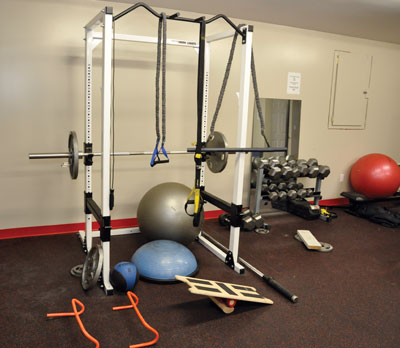 |
|
| The Scugog fire department in Ontario purchased portable, functional-based equipment that is best for full-body training and can be adapted to meet the needs of everyone using it. | |
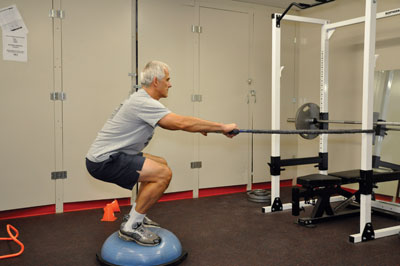 |
|
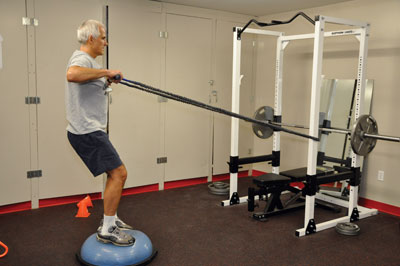 |
|
| Scugog, Ont., firefighter Don Buldyke performs a multi-joint (bending his knees, hips and ankles) squat-to-row on the BOSU with a smart toner. This is a full-body or whole-body movement that activates the core and improves balance. This movement increases the metabolic output and calorie expenditure by activating a lot of muscle groups. |
|
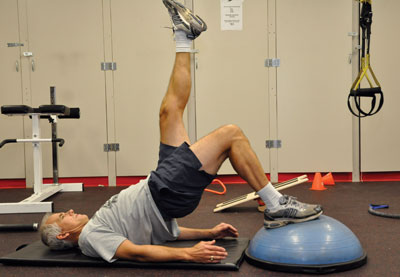 |
|
| Buldyke works his hamstrings, glutes and core with a single leg lift on the BOSU balance trainer. The BOSU is great for performing other floor- or bench-based exercises, including sit-ups and pushups. |
|
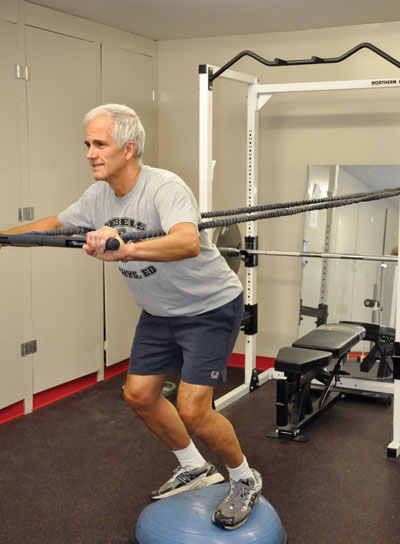 |
|
| Buldyke performs a multi-joint squat/chest press with a smart toner on the BOSU balance trainer. This exercise helps develop the pushing muscles (chest, triceps and shoulders) and legs. (Photos by Todd Aitken)
|
I was involved in the design and development of the gym at Scugog Township Station 1, in Port Perry, Ont. Scugog Township is 65 kilometres northeast of Toronto, with a population of 22,000 and a land area of 475 square kilometres. In 2005, the fire department went from part-time to composite with the hiring of its first two full-time suppression staff. Today, there are six full-time staff and 47 volunteer (or paid, on-call/part-time) firefighters responding from two fire stations, one in Port Perry and the other in Caesarea. Last year, the fire department responded to 780 calls.
Here’s how we set up a fully functional fire-hall gym to meet the needs of our firefighters and keep them in tip-top shape.
Shortly after the fire hall was rebuilt in 2001, the part-time firefighters approached Fire Chief Richard Miller about the possibility of building a gym in the mezzanine, which, at that time, was being used for storage. We were fortunate to have firefighters who, as carpenters, painters and electricians, were willing to do a lot of the work. The gym came together relatively easily, since everyone pitched in and offered their time, effort and expertise. We were also fortunate to have a suitable room that (with some work and planning) developed into a good training area.
“I think it is great that the firefighters took it upon themselves to build a gym,” said Chief Miller. “It is a great way to not only prepare yourself for an emergency, but it also builds camaraderie and teamwork.”
The mezzanine area was still needed for storage, so we added a closet and a cupboard to house the extra gear. We were left with a six-metre by 7.3-metre room for gym use. After we painted the walls and the department arranged for the installation of rubber flooring, we were ready to buy the equipment. We wanted the equipment to be suitable for all fitness levels and to accommodate several firefighters at a time. We had about $2,000 to work with, from the chief’s budget and money raised by the Port Perry Firefighters Association.
We elected to buy portable, functional-based equipment. We wanted equipment that could easily be adapted to suit the workout style of those using it. Functional equipment is more reasonably priced than machines, which are often expensive and bulky. In addition, functional-based equipment is for full-body training. This met the needs of everyone who would use the gym; we were looking for equipment designed to strengthen the entire body, as opposed to using several machines that are usually designed to strengthen just one particular muscle group.
Functional training builds bodies from the inside out, allowing for a greater focus on training for specific firefighting activities, such as raising and lowering ladders, advancing hose lines, lifting or carrying victims, using heavy hydraulic tools or carrying a hose pack up stairs.
Initially, we bought a rack with a pull-up bar, an Olympic bar, free-weights, a set of five-pound to 60-pound dumbbells, a BOSU balance trainer, a stability ball, a skipping rope and a reconditioned, commercial treadmill.
Over the years, additional equipment was purchased and firefighters from Port Perry and Caesarea donated some of their own pieces of equipment, such as a stationary bike for cardio training; a TRX suspension trainer for full-body training; smart toners for chest presses, rows, bicep curls and other exercises; a hyperextension machine for the glutes and lower back; and a dip station for the chest (pectorals) and triceps. We also added a TV, a stereo, a water cooler, a fan, a clock and mirrors.
Functional equipment is typically found in athletic training centres rather than in fitness and health clubs. Because of this, several firefighters hadn’t used certain pieces of equipment, so some initial training on the functional equipment was required. After a couple of sessions, during which I introduced the equipment to the firefighters and demonstrated functional exercises, the members gradually began to buy into the concept of functional training.
Traditional gyms focus on developing and improving cardiovascular endurance, muscular strength and body composition. Strength is developed through repetitive overloading of a muscle. On the other hand, athletic, functional training is movement based, incorporating speed, agility, anaerobic conditioning, power, balance, core stability, quickness and functional strength.
“Functional training is a lot harder than it looks,” says Scugog firefighter Don Buldyke. “It uses a lot of muscles to stabilize the body.”
Buldyke notes that he had been watching a television program about the way pro hockey players train in the off season and was impressed to see them using the same equipment we have in our gym.
Many fire halls do not have the luxury of a dedicated room for fitness training. A makeshift fitness centre is often set up in the training room or at the back of the bays. If this is your only option, here is a list of equipment that can be set up very quickly, almost anywhere. This equipment can be used to improve entire body strength and core stability (check your local athletic supply store for prices).
BOSU balance trainers: BOSU is an acronym for both sides up. You can use the BOSU to perform floor- or bench-based exercises, such as lunges, pushups and squats. Use the BOSU with other pieces of equipment to integrate balance with strength training.
Ballast ball: This is an anti-burst stability ball that can be used on its own for a complete workout, or in conjunction with other pieces of equipment to improve core stability and balance.
TRX suspension trainer: This piece of equipment was developed by U.S. Navy Seals to help them remain in peak condition. Users at all fitness levels can perform functional exercises to improve strength, power, flexibility and mobility. It is a full-body workout with body weight acting as the resistance.
Smart toners: These bands are available in a variety of resistance levels, ranging from 4.5 to 30 kilograms (10 to 55 pounds). The toners are ideal pieces of equipment to build strength and rotary power; they add resistance throughout the whole movement. They are ideal for pushing/pulling exercises, such as chest presses and rows. Standing on a BOSU while performing a chest press increases the complexity and intensity of the exercise by introducing instability.
Medicine balls: A 4.5- to 5.4- kilogram medicine ball is ideal for throwing and passing as an explosive exercise.
Micro hurdles: These mini-hurdles (six inches high) are often used by hockey, soccer and football players to improve their lateral movement, agility and foot speed.
Catalyst Performance System: I have never used this piece of equipment, so I asked Douglas Brooks, an exercise physiologist and director of athletic conditioning at Sugar Bowl Ski Academy at Lake Tahoe, Calif., for his opinion. “This equipment rocks,” he said. “We use it all the time. I love it and so do my athletes. It’s versatile for clipping in toners, great for plyos, and is adjustable and easy to anchor with plates in the centre of the unit when working with heavy loads. As long as you have the square footage to work with, I highly recommend it.”
Any fire hall that has the co-operation and goodwill of its members can implement a functional-based gym with a reasonable budget and work schedule. Once the gym is in place and the firefighters become familiar with the equipment, exercise programs can be easily designed for firefighters of all levels of participation and performance. Functional-based equipment offers everyone the opportunity to benefit from even the most basic physical activities, as well as more extensive and specialized training sessions.
Todd Aitken has served for 10 years with the Scugog Fire Department in Ontario and is a captain at Toronto Pearson Fire Department. He works part time at Twist Sport Conditioning Centre where, as a coach (TSCC-Gold), he trains elite athletes and firefighter combat challenge participants. He is a graduate of the Ontario Fire College company officer diploma program and the Seneca College fire protection engineering technician program. Todd is working on his bachelor of fire and safety studies at the Justice Institute of British Columbia and his bachelor of arts in public administration and governance at Ryerson University.
Print this page